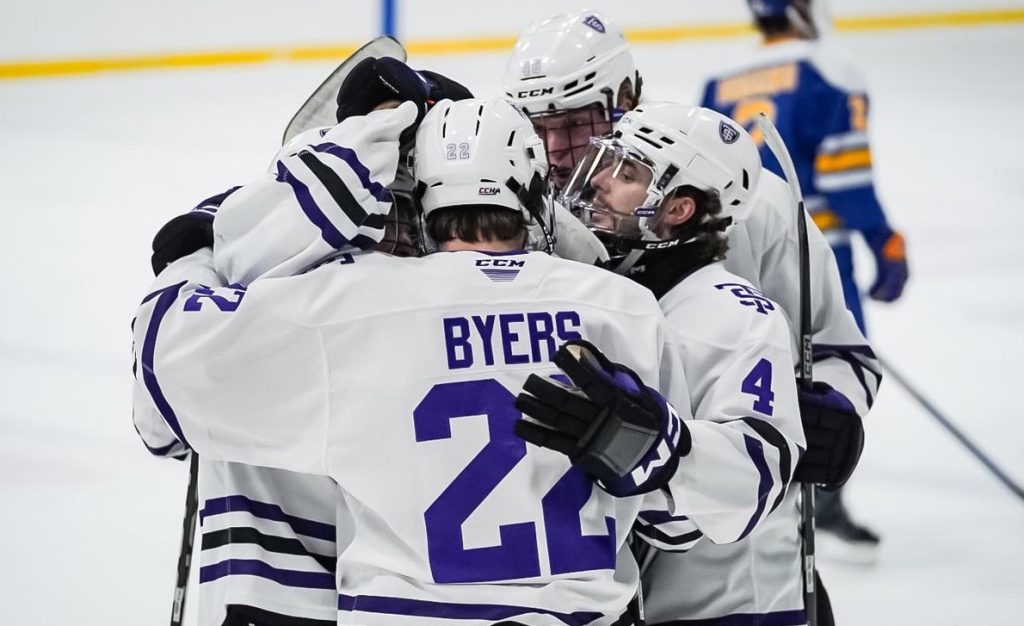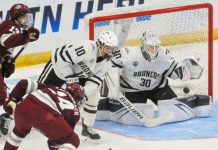
Each week during the season, we look at the big events and big games around Division I men’s college hockey in Tuesday Morning Quarterback.
Dan: A hearty and happy Tuesday to you all, and a special happy holiday season as we break into December.
I’m sure, Paula, that Midwest winters are coming just as the New England snow and cold is on the way, but I’d like to think that those of us out east can offer some solace since we’ve been sitting on 50 degrees for the better part of the last week or so…unless it means Boston is going to fall into the ocean.
Speaking of falling into the sea (and that was even a bad bridge by my standards), I’m still breathless from the hockey we experienced over the weekend. Every league had something to offer, but I think everything begins with the Denver-North Dakota series out in Colorado.
It had it all, including a major North Dakota comeback, and I left that series thinking that those two teams were the best teams in the country (right now). For a Boston guy who loves, eats, sleeps Boston hockey, it wasn’t even that difficult to swallow the pill. Both teams deserve top billing in the country, but at the end of the day, North Dakota was a hair better, and that’s why four of six points went back to Grand Forks.
What were your takeaways from the weekend, and what else could have contended with North Dakota-DU?
Paula: Oh, Dan, what a series! And I think that the voters probably got it right even though I didn’t agree with the majority of them this week.
That North Dakota comeback was, indeed, spectacular and any game in which the Fighting Hawks and Pioneers combine for a dozen goals – with each team recording separate four-goal periods – but what elevated that series even further is the way in which Denver came back from behind to win in OT the following night.
I can’t say enough about the play of Zeev Buium, Carter King and Massimo Rizzo. Buium’s goal to tie the game midway through the third was one thing, but the game-winning goal was everything hockey should be, with Buium and Rizzo skating in two-on-one, Rizzo taking the shot, and the rebound coming to King crashing in as the third man on the rush. There are some goals for which highlight reels are made, and that is one of them.
That series epitomized what college hockey should be. It felt like playoff hockey. I love that both the Fighting Hawks and the Pioneers are playing this way in December.
As I said, though, I didn’t agree with the majority of poll voters this week and it’s not because I don’t think North Dakota is deserving of the top spot. My pick, though, was Boston University. At this point in the season, I have a soft spot for teams that take care of business when they can, and the Terriers certainly did that against Merrimack, outscoring the Warriors 9-3 in two games and ending the first half of the season seven full points behind two excellent second-place Hockey East teams.
Other teams that took care of things nicely by beating teams they should have include No. 5 Quinnipiac – another strong candidate for first in the nation – No. 6 Wisconsin and No. 8 Maine. Collectively, the Bobcats, Badgers and Black Bears outscored opponents 31-7. Quinnipiac and Wisconsin allowed one goal each all weekend.
After a couple of months of genuine parity play, Dan, are we finally seeing some teams pull away and begin to create definition within their conferences?
Dan: Surprisingly, I don’t think anyone is truly pulling away. I feel like everyone is facing a threat in their leagues, and I think we’re seeing more parity than ever before.
The only league where any team should probably feel comfortable is ECAC, and that’s largely because a “work-in-progress” Quinnipiac team is still proving itself better than the rest of a league that’s heading for one or two bids at most this year. That’s a conversation for another day, maybe even later in this space, but the results from a team that sent four teams to last year’s tournament has been grisly at best so far.
BU has a seven-point lead in Hockey East, but I’d argue that Maine is the best team in the league right now. Boston College is coming off being No. 1 in the nation, and both Providence and New Hampshire are right in the thick of the fight. Any type of regression from those top three teams could send them spiraling into fifth or sixth, where UMass is currently sitting.
Atlantic Hockey is notoriously even, and RIT is the lone team ranked despite being in second place in the conference. AIC is creeping up the standings, Holy Cross is standard, Bentley is one of the most pleasant surprises in the country (top five defense!), and Niagara and Canisius round down to sixth and seventh. The only team that’s mathematically got some ground to cover is Robert Morris, but I remember a year where Derek Schooley took a one-win team at Christmas to fourth or fifth place and a conference championship.
St. Thomas leads the CCHA.
Hold on a second, I’m going to let people read that again.
OK, we’re back. St. Thomas leads the CCHA by two points over Michigan Tech, and Minnesota State and Bemidji State are right there. Lake Superior State and Northern Michigan are a weekend’s work away from catching even the top of the league.
And then there’s the NCHC, where North Dakota and Denver are actually trailing St. Cloud State. Western Michigan is getting itself right, and Omaha is there. Miami is probably the one team that I’m counting out because it’s yet to win a league game.
I can’t remember anything being this tight at the holidays, but here I am, loving every second. I recognize that this is going to shift over the next month, most likely, but the surprises are there.
For me, the biggest surprise is, like I mentioned, Bentley. My Falcons were picked dead-last in Atlantic Hockey before the season but have only been swept once this season with a pair of 2-0 losses to Holy Cross. Andy Jones has this team clicking, and the nonconference games against BU and UMass Lowell impressed just how far this team is coming with embracing its new style. I don’t know if it’s enough to make a run this year, especially in a league that’s usually one bid, but I’m thoroughly enjoying the hockey.
That’s always an interesting group of teams – surprising and enjoyable, yet not likely to make the tournament. Find me a team that you love that fits that bill – just a good old fashioned fun team to watch, even if the odds are still against them winning their league or making the tournament.
Paula: For me, that team would be Alaska, a sentimental favorite from my days covering the Nanooks in the CCHA as well as a team whose fate tugs at my heart because of its status as an orphan. Nothing against the other nonaffiliated teams, but the Nanooks are showing some flare this season.
Last weekend, the Nanooks swept in-state rival Alaska Anchorage to take their 13th straight Governor’s Cup, the trophy awarded to the Alaska team with the most wins against the other. Since the Nanooks swept the Seawolves earlier in November, Alaska has four games of a possible six this season over Anchorage and, so, the Cup.
Back to that theme of taking care of business, the Nanooks outscored the Seawolves 8-1 in the two games in Anchorage. Right now, Alaska is averaging 3.5 goals per game, 13th best in the nation with a defense allowing 2.50 (15th).
Up front, the Nanooks have Brady Risk with his eight goals and 12 assists, ninth nationally for points per game, plus Harrison Israels (11 goals, four assists) and Anton Rubtsov (four goals, 10 assists) who are both among the top 40 or so point-getters nationally. On top of that, Pierce Charleson (2.11GAA, .922 SV%) is backstopping the Nanooks to the nation’s 15th-best team defense (2.50).
Sure, their schedule doesn’t provide a complete picture of how competitive they are, but the Nanooks have played well against St. Cloud and Michigan Tech and they’ll be tested in the second half in the Great Lakes Invitational, with a road series against North Dakota and two series against Arizona State.
They’re playing solid hockey, but they may as well be playing on the moon. It’s a shame.
Pivoting a bit back to what you said about conferences feeling really tight. I agree that they do, but I still contend that some programs may be creating some space – even with half a season left. That tightness, I think, makes it just as difficult to catch a leading team as it does to remain at the top of the standings.
I’m thinking of the Big Ten, specifically. Eight points separate sixth-place Penn State from first-place Michigan State. The teams between – Michigan, Minnesota, Notre Dame, Wisconsin – all have the talent, time and opportunity to make a run for a regular-season title. The problem, though, is that those six teams are all so equally matched that splitting with each other for the remainder of the season as many of them will won’t create much movement in the conference.
That’s why I think Wisconsin’s sweep of last-place Ohio State was so important this week with Michigan State idle and the four other teams in the mix splitting series. That’s why I think what BU and Quinnipiac did was important, too, heading into the midseason break.
And that’s all I’ll say about that.
Hey, how about those Nadeau brothers?
Dan: Oh, you mean the two guys with nearly the same stat lines for a Maine team that, and I repeat, is probably running as one of the best and hottest in the country?
Josh singlehandedly put his name into the annals of the UNH-Maine rivalry with a hat trick on Friday before Bradly scored three times against UConn on Sunday. They’ve got a near-identical stat line, and they’re running Maine straight up the polls after everybody lost hope about the ability for the Black Bears to win in the northern reaches of Hockey East. Needless to say, they’re headlining exactly what Maine needed after Jeremy Swayman had that team in the tournament before COVID knocked everything out.
I love Maine – obviously – but I’m also very much on board with what it means to have a GOOD Maine team rocking into college hockey. Derek Schooley mentioned this on the USCHO Weekend Review podcast, but there were 4,661 people at Alfond Arena for the Sunday afternoon game against UConn. That’s a near-sellout on an NFL Sunday opposite a slate of games that normally draws people to watering holes and establishments for wings and adult beverages. In Orono, 4,661 people chose to instead watch college hockey, though, as I noted, a New England pro football day actually doesn’t sound all that great right now.
I don’t know about this run’s sustainability after the holidays and into the second half, but it sure is fun right now.
We have time for a quick point or two before the week ends, but I didn’t want to wrap up without mentioning Delaware hockey. For those who missed it, the University of Delaware announced it would add women’s hockey and join College Hockey America in July, 2025. The Blue Hens will hire a head coach in the next year before spending a year building a program that will eventually take the ice for the 2025-2026 season, and they bring women’s hockey closer to 50 overall teams with their addition.
I didn’t realize that Delaware had ice rinks readily available, but the proximity to Philadelphia makes sense for a school that needed to offset its Title IX spending after moving to the bowl subdivision in football. The addition of women’s hockey taps them into a growing talent pool, and I love, love, love, love the thought of another women’s hockey program coming to Division I. Maybe it’s because I’m looking at my two daughters as I write this, but I’m dreaming about the possibilities if they ask me to put on skates. Combined with the new women’s hockey pro league, the game is growing at a rapid rate, and I’m so excited for commissioner Michelle Morgan and the entire CHA family.
We’ve both been around hockey for a long time and seen a ton of developments – positive and negative – through the years. I just hope this is the next step in growth and equality for a sport that needs and deserves this moment.
Paula: I’m with you on all of this. Anything that adds to the growth of the sport we love is great. I love that Maine – another sentimental favorite of mine – is getting so much support while playing really entertaining hockey. Delaware is an excellent addition to the women’s Division I family, and who doesn’t love a hockey team whose mascot is the Blue Hens?
The worst years of COVID aside, participation youth hockey in the U.S. has grown steadily in the past decade and the involvement of women and girls continues to outpace that of their male counterparts. According to USA Hockey’s 2022-23 membership report, while women and girls account for about 15% of participation in amateur hockey overall, the rate at which the sport is growing for women and girls outpaces that of growth for men and boys every year.
And according to the report, hockey is growing in states that don’t immediately leap to mind when discussing hockey, like Arkansas, Idaho, and Virginia. The three big M states – Minnesota, Massachusetts, Michigan – which have been the cradle of amateur hockey for decades saw no growth to negative growth in the past year.
The expansion of the NHL throughout the U.S. certainly helps to fuel the interest in playing hockey, and the more kids that play, the better our chances of seeing the D-I footprint increase.
I admit to having being somewhat cynical about the growth of D-I programs on the men’s side for a number of reasons, not the least of which is the cost. Hockey is an expensive sport in many different ways. The challenges aren’t limited to the cost of facilities. There’s so much more. Add to that the difficulty of conference alignment and membership, and I get a bit discouraged.
I will say this, though. Having spoken with the conference commissioners at the start of this season, I think the sport is in excellent hands. I’m confident that the men’s D-I leadership group is the right bunch of humans to navigate some really odd post-COVID, early 21st century waters.
And I can’t wait to get my Blue Hens merch.


